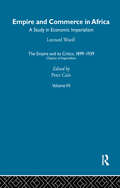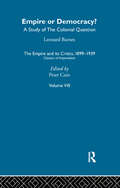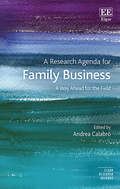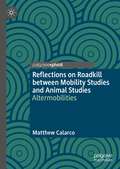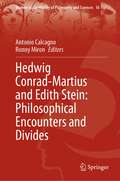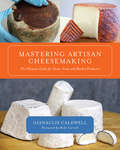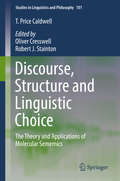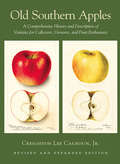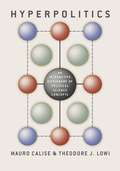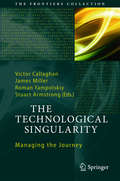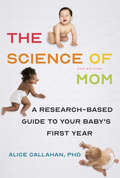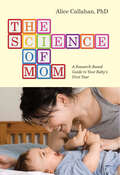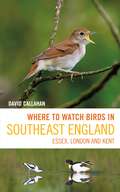- Table View
- List View
The Empire and its Critics, 1899-1939: Classics of Imperialism
by Peter CainThe eight books reprinted in this set played an important role in defining attitudes and expectations about imperialism on the British Left in the twentieth century. They are vital in understanding the transition from the liberal anti-imperialism of the nineteenth century to the more overtly socialist critiques of the twentieth.
The Empire and its Critics, 1899-1939: Classics of Imperialism
by Peter CainThe eight books reprinted in this set played an important role in defining attitudes and expectations about imperialism on the British Left in the twentieth century. They are vital in understanding the transition from the liberal anti-imperialism of the nineteenth century to the more overtly socialist critiques of the twentieth.
Research Methods For Human-computer Interaction (PDF)
by Paul Cairns Anna CoxHuman-Computer Interaction draws on the fields of computer science, psychology, cognitive science, and organisational and social sciences in order to understand how people use and experience interactive technology. Until now, researchers have been forced to return to the individual subjects to learn about research methods and how to adapt them to the particular challenges of HCI. This is the first book to provide a single resource through which a range of commonly used research methods in HCI are introduced. Chapters are authored by internationally leading HCI researchers who use examples from their own work to illustrate how the methods apply in an HCI context. Each chapter also contains key references to help researchers find out more about each method as it has been used in HCI. Topics covered include experimental design, use of eyetracking, qualitative research methods, cognitive modelling, how to develop new methodologies and writing up your research.
Drifting - Architecture and Migrancy (Architext)
by Stephen CairnsTo dwell in these globalizing times requires us to negotiate increasingly palpable flows - of capital, ideas, images, goods, technology, and people. Such flows seem to pressurize, breach and sometimes even disaggregate the places we always imagined to be distinctive and stable. This book is focussed on the interaction of two elements within this contemporary situation. The first is the very idea of a place we imagine to be distinctive and stable. This idea is explored through architecture, the institution that in the West has claimed the responsibility for imagining and producing places along these lines. The second element is a particular kind of global flow, namely the human flows of immigrants, refugees, exiles, guestworkers and other migrant groups. This book carefully inspects the intersections between architectures of place and flows of migrancy. It does so without seeking to defend the idea of place, nor lament its passing. Rather this book is an exploration of the often complex and unorthodox modes of dwelling that are emerging precisely from within the ruins of the idea of place. This exploration is informed by critical analyses of architecture and urbanism, and their representation in media such as film.The book is animated empirically by a set of overlapping and intersecting trajectories that shift from Hong Kong to Canada, Australia and Germany; from Southern Europe to Australia; from Britain to India, Canada and New Zealand; from Southeast Asia, to the Pacific Islands, to New Zealand; and from Latin America and East Asia to the United States. But each geographical context discussed represents only one point within a wider pattern of movement that implicates other localities, and so signals the very undoing of a unified geographical logic.
Drifting - Architecture and Migrancy (Architext)
by Stephen CairnsTo dwell in these globalizing times requires us to negotiate increasingly palpable flows - of capital, ideas, images, goods, technology, and people. Such flows seem to pressurize, breach and sometimes even disaggregate the places we always imagined to be distinctive and stable. This book is focussed on the interaction of two elements within this contemporary situation. The first is the very idea of a place we imagine to be distinctive and stable. This idea is explored through architecture, the institution that in the West has claimed the responsibility for imagining and producing places along these lines. The second element is a particular kind of global flow, namely the human flows of immigrants, refugees, exiles, guestworkers and other migrant groups. This book carefully inspects the intersections between architectures of place and flows of migrancy. It does so without seeking to defend the idea of place, nor lament its passing. Rather this book is an exploration of the often complex and unorthodox modes of dwelling that are emerging precisely from within the ruins of the idea of place. This exploration is informed by critical analyses of architecture and urbanism, and their representation in media such as film.The book is animated empirically by a set of overlapping and intersecting trajectories that shift from Hong Kong to Canada, Australia and Germany; from Southern Europe to Australia; from Britain to India, Canada and New Zealand; from Southeast Asia, to the Pacific Islands, to New Zealand; and from Latin America and East Asia to the United States. But each geographical context discussed represents only one point within a wider pattern of movement that implicates other localities, and so signals the very undoing of a unified geographical logic.
A Research Agenda for Family Business: A Way Ahead for the Field (Elgar Research Agendas)
by Andrea CalabroElgar Research Agendas outline the future of research in a given area. Leading scholars are given the space to explore their subject in provocative ways, and map out the potential directions of travel. They are relevant but also visionary. This exciting Research Agenda expertly addresses the question: What will be important within the family business field and for family businesses in practice over the next decade? Top international contributors explore farsighted theories, methods and topics, often taking a multi-disciplinary approach in order to outline the potential routes for further advancing family business research. Chapters cover the significance of new family trends, entrepreneurial legacy, board diversity, spatial-familiness, corruption, innovation and digital business transformation, challenging core assumptions surrounding the family business phenomenon and mapping the future of the discipline. A Research Agenda for Family Business will prove a stimulating read for family business and entrepreneurship scholars, as well as academics focusing on strategy, HR, organizational behaviour and corporate governance. Practitioners will also find this book valuable for reflecting on challenges that they are facing and navigating developments in the family business field.
An Einstein Encyclopedia
by Alice Calaprice Daniel Kennefick Robert SchulmannThis is the single most complete guide to Albert Einstein's life and work for students, researchers, and browsers alike. Written by three leading Einstein scholars who draw on their combined wealth of expertise gained during their work on the Collected Papers of Albert Einstein, this authoritative and accessible reference features more than one hundred entries and is divided into three parts covering the personal, scientific, and public spheres of Einstein’s life.An Einstein Encyclopedia contains entries on Einstein’s birth and death, family and romantic relationships, honors and awards, educational institutions where he studied and worked, citizenships and immigration to America, hobbies and travels, plus the people he befriended and the history of his archives and the Einstein Papers Project. Entries on Einstein’s scientific theories provide useful background and context, along with details about his assistants, collaborators, and rivals, as well as physics concepts related to his work. Coverage of Einstein’s role in public life includes entries on his Jewish identity, humanitarian and civil rights involvements, political and educational philosophies, religion, and more.Commemorating the hundredth anniversary of the theory of general relativity, An Einstein Encyclopedia also includes a chronology of Einstein’s life and appendixes that provide information for further reading and research, including an annotated list of a selection of Einstein’s publications and a review of selected books about Einstein.More than 100 entries cover the rich details of Einstein’s personal, professional, and public lifeAuthoritative entries explain Einstein’s family relationships, scientific achievements, political activities, religious views, and moreMore than 40 illustrations include photos of Einstein and his circle plus archival materialsA chronology of Einstein’s life, appendixes, and suggestions for further reading provide essential details for further research
An Einstein Encyclopedia (PDF)
by Alice Calaprice Daniel Kennefick Robert SchulmannThis is the single most complete guide to Albert Einstein's life and work for students, researchers, and browsers alike. Written by three leading Einstein scholars who draw on their combined wealth of expertise gained during their work on the Collected Papers of Albert Einstein, this authoritative and accessible reference features more than one hundred entries and is divided into three parts covering the personal, scientific, and public spheres of Einstein’s life.An Einstein Encyclopedia contains entries on Einstein’s birth and death, family and romantic relationships, honors and awards, educational institutions where he studied and worked, citizenships and immigration to America, hobbies and travels, plus the people he befriended and the history of his archives and the Einstein Papers Project. Entries on Einstein’s scientific theories provide useful background and context, along with details about his assistants, collaborators, and rivals, as well as physics concepts related to his work. Coverage of Einstein’s role in public life includes entries on his Jewish identity, humanitarian and civil rights involvements, political and educational philosophies, religion, and more.Commemorating the hundredth anniversary of the theory of general relativity, An Einstein Encyclopedia also includes a chronology of Einstein’s life and appendixes that provide information for further reading and research, including an annotated list of a selection of Einstein’s publications and a review of selected books about Einstein.More than 100 entries cover the rich details of Einstein’s personal, professional, and public lifeAuthoritative entries explain Einstein’s family relationships, scientific achievements, political activities, religious views, and moreMore than 40 illustrations include photos of Einstein and his circle plus archival materialsA chronology of Einstein’s life, appendixes, and suggestions for further reading provide essential details for further research
Reflections on Roadkill between Mobility Studies and Animal Studies: Altermobilities
by Matthew CalarcoRoadkill is a recurrent but often unthought feature of modern life. Yet, consideration of the broader significance of the myriad social, ethical, and political issues related to roadkill has largely gone missing from mainstream scholarship and activism. This neglect persists even in fields such as mobility studies and animal studies that would otherwise seem to have a vested interest in the topic. This book aims to bring roadkill to the foreground of current discussions among scholars and activists in these fields in order to demonstrate that roadkill is a uniquely important site from which to understand and contest the machinations of the dominant social order. It argues that a careful examination of roadkill can help both to uncover the hidden violence of contemporary human-centered systems of mobility and to develop alternative modes of mobility for a renewed social life in common with our more-than-human kin.
Hedwig Conrad-Martius and Edith Stein: Philosophical Encounters and Divides (Women in the History of Philosophy and Sciences #16)
by Antonio Calcagno Ronny MironThis book focuses on the unique philosophical relationship between Hedwig Conrad-Martius and Edith Stein. The two phenomenologists discussed and debated insights and ideas about the nature of the soul, phenomenology, personhood and individuality, animal life, nature, being, and God. This book brings together for the first time leading international scholars of phenomenology to explore the philosophical exchange between both Conrad-Martius and Stein. This is an important book for understanding the development of the phenomenological movement and key phenomenological ideas and methods. It provides a critical and comprehensive overview of the key issues that helped frame both phenomenologists’ philosophical trajectories. Additionally, the ideas of Conrad-Martius and Stein are mined to address contemporary questions surrounding such topics as personal identity, animal versus human personhood, contemporary atheism, and the relationship between religion and science. The book will have great appeal to phenomenologists, philosophers, and historians of philosophy.
Scots in Canada
by Jenni CalderIn Canada there are nearly as many descendants of Scots as there are people living in Scotland; almost 5 million Canadians ticked the "Scottish origin" box in the most recent Canadian Census. Many Scottish families have friends or relatives in Canada. Who left Scotland? Why did they leave? What did they do when they got there? What was their impact on the developing nation? Thousands of Scots were forced from their homeland, while others chose to leave, seeking a better life. As individuals, families and communities, they braved the wild Atlantic Ocean, many crossing in cramped under-rationed ships, unprepared for the fierce Canadian winter. And yet Scots went on to lay railroads, found banks and exploit the fur trade, and helped form the political infrastructure of modern day Canada. This book follows the pioneers west from Nova Scotia to the prairie frontier and on to the Pacific coast. It examines the reasons why so many Scots left their land and families. The legacy of centuries of trade and communication still binds the two countries, and Scottish Canadians keep alive the traditions that crossed the Atlantic with their ancestors. REVIEW: ...meticulously researched and fluently written… it neatly charts the rise of a country without succumbing to sentimental myths. SCOTLAND ON SUNDAY
Mastering Artisan Cheesemaking: The Ultimate Guide for Home-Scale and Market Producers
by Gianaclis Caldwell Ricki CarrollThe key to becoming a successful artisan cheesemaker is to develop the intuition essential for problem solving and developing unique styles of cheeses. There are an increasing number of books on the market about making cheese, but none approaches the intricacies of cheesemaking science alongside considerations for preparing each type of cheese variety in as much detail as Mastering Artisan Cheesemaking. Indeed, this book fills a big hole in the market. Beginner guides leave you wanting more content and explanation of process, while recipe-based cookbooks often fail to dig deeper into the science, and therefore don’t allow for a truly intuitive cheesemaker to develop. Acclaimed cheesemaker Gianaclis Caldwell has written the book she wishes existed when she was starting out. Every serious home-scale artisan cheesemaker—even those just beginning to experiment—will want this book as their bible to take them from their first quick mozzarella to a French mimolette, and ultimately to designing their own unique cheeses. This comprehensive and user-friendly guide thoroughly explains the art and science that allow milk to be transformed into epicurean masterpieces. Caldwell offers a deep look at the history, science, culture, and art of making artisan cheese on a small scale, and includes detailed information on equipment and setting up a home-scale operation. A large part of the book includes extensive process-based recipes dictating not only the hard numbers, but also the concepts behind each style of cheese and everything you want to know about affinage (aging) and using oils, brushes, waxes, infusions, and other creative aging and flavoring techniques. Also included are beautiful photographs, profiles of other cheesemakers, and in-depth appendices for quick reference in the preparation and aging room. Mastering Artisan Cheesemaking will also prove an invaluable resource for those with, or thinking of starting, a small-scale creamery. Let Gianaclis Caldwell be your mentor, guide, and cheering section as you follow the pathway to a mastery of cheesemaking. For the avid home hobbyist to the serious commercial artisan, Mastering Artisan Cheesemaking is an irreplaceable resource.
Discourse, Structure and Linguistic Choice: The Theory and Applications of Molecular Sememics (Studies in Linguistics and Philosophy #101)
by T. Price Caldwell Oliver Cresswell Robert J. StaintonThis volume presents eight papers and a draft monograph by T. Price Caldwell on topics in linguistics, semiotics and philosophy of language. From the beginning of his professional career onwards, Caldwell wrote short fiction and poetry, and he taught English literature. The relevance to these of philosophy of language, semiotics and certain areas of linguistics increasingly caught his interest. This book presents the fruits of this later work. Of the papers included here, two are abstract and theoretical, focusing on linguistic methodology and Caldwell’s overarching views on the nature of meaning-in-context. His position here, which he called Molecular Sememics, echoes early Structuralism and Functionalism, but addresses shortfalls in each. Two other papers apply the method and theory to topics within semantics and pragmatics, including especially the structuring of discourse. The remaining four papers connect Caldwell’s theoretical insights to his life-long interests in fiction and pedagogy. The monograph – which Caldwell was left unfinished due to illness – aims to present as a single intellectual package the theory and the applications.
The Genesis of Fluid Mechanics 1640-1780 (Studies in History and Philosophy of Science #22)
by Julián Simón CaleroFluid Mechanics, as a scientific discipline in a modern sense, was established between the last third of the 17th century and the first half of the 18th century. This book analyses its genesis from two lines: resistance and discharge. This approach highlights the existence of a remarkable experimental aspect in the aforementioned research lines, together with their link with problems of a practical nature, such as ballistics, hydraulics, fluid-using machines or naval theory.
Old Southern Apples: A Comprehensive History and Description of Varieties for Collectors, Growers, and Fruit Enthusiasts, 2nd Edition
by Creighton Lee CalhounA book that became an instant classic when it first appeared in 1995, Old Southern Apples is an indispensable reference for fruit lovers everywhere, especially those who live in the southern United States. Out of print for several years, this newly revised and expanded edition now features descriptions of some 1,800 apple varieties that either originated in the South or were widely grown there before 1928. Author Lee Calhoun is one of the foremost figures in apple conservation in America. This masterwork reflects his knowledge and personal experience over more than thirty years, as he sought out and grew hundreds of classic apples, including both legendary varieties (like Nickajack and Magnum Bonum) and little-known ones (like Buff and Cullasaga). Representing our common orchard heritage, many of these apples are today at risk of disappearing from our national table. Illustrated with more than 120 color images of classic apples from the National Agricultural Library’s collection of watercolor paintings, Old Southern Apples is a fascinating and beautiful reference and gift book. In addition to A-to-Z descriptions of apple varieties, both extant and extinct, Calhoun provides a brief history of apple culture in the South, and includes practical information on growing apples and on their traditional uses.
Hyperpolitics: An Interactive Dictionary of Political Science Concepts
by Mauro Calise Theodore J. LowiFifteen years in the making, Hyperpolitics is an interactive dictionary offering a wholly original approach for understanding and working with the most central concepts in political science. Designed and authored by two of the discipline’s most distinguished scholars, its purpose is to provide its readers with fresh critical insights about what informs these political concepts, as well as a method by which readers—and especially students—can unpack and reconstruct them on their own. International in scope, Hyperpolitics draws upon a global vocabulary in order to turn complex ideas into an innovative teaching aid. Its companion open access website (www.hyperpolitics.net) has already been widely acknowledged in the fields of education and political science and will continue to serve as a formidable hub for the book’s audience. Much more than a dictionary and enhanced by dynamic graphics, Hyperpolitics introduces an ingenious means of understanding complicated concepts that will be an invaluable tool for scholars and students alike.
Hyperpolitics: An Interactive Dictionary of Political Science Concepts
by Mauro Calise Theodore J. LowiFifteen years in the making, Hyperpolitics is an interactive dictionary offering a wholly original approach for understanding and working with the most central concepts in political science. Designed and authored by two of the discipline’s most distinguished scholars, its purpose is to provide its readers with fresh critical insights about what informs these political concepts, as well as a method by which readers—and especially students—can unpack and reconstruct them on their own. International in scope, Hyperpolitics draws upon a global vocabulary in order to turn complex ideas into an innovative teaching aid. Its companion open access website (www.hyperpolitics.net) has already been widely acknowledged in the fields of education and political science and will continue to serve as a formidable hub for the book’s audience. Much more than a dictionary and enhanced by dynamic graphics, Hyperpolitics introduces an ingenious means of understanding complicated concepts that will be an invaluable tool for scholars and students alike.
Hyperpolitics: An Interactive Dictionary of Political Science Concepts
by Mauro Calise Theodore J. LowiFifteen years in the making, Hyperpolitics is an interactive dictionary offering a wholly original approach for understanding and working with the most central concepts in political science. Designed and authored by two of the discipline’s most distinguished scholars, its purpose is to provide its readers with fresh critical insights about what informs these political concepts, as well as a method by which readers—and especially students—can unpack and reconstruct them on their own. International in scope, Hyperpolitics draws upon a global vocabulary in order to turn complex ideas into an innovative teaching aid. Its companion open access website (www.hyperpolitics.net) has already been widely acknowledged in the fields of education and political science and will continue to serve as a formidable hub for the book’s audience. Much more than a dictionary and enhanced by dynamic graphics, Hyperpolitics introduces an ingenious means of understanding complicated concepts that will be an invaluable tool for scholars and students alike.
The Technological Singularity: Managing the Journey (The Frontiers Collection)
by Victor Callaghan James Miller Roman Yampolskiy Stuart ArmstrongThis volume contains a selection of authoritative essays exploring the central questions raised by the conjectured technological singularity. In informed yet jargon-free contributions written by active research scientists, philosophers and sociologists, it goes beyond philosophical discussion to provide a detailed account of the risks that the singularity poses to human society and, perhaps most usefully, the possible actions that society and technologists can take to manage the journey to any singularity in a way that ensures a positive rather than a negative impact on society. The discussions provide perspectives that cover technological, political and business issues. The aim is to bring clarity and rigor to the debate in a way that will inform and stimulate both experts and interested general readers.
The Science of Mom: A Research-Based Guide to Your Baby's First Year
by Alice CallahanNow updated! The new edition of this best-selling guide uses science to tackle some of the most important decisions facing new parents—from sleep training and vaccinations to breastfeeding and baby food.Is cosleeping safe? How important is breastfeeding? Are food allergies preventable? Should we be worried about the aluminum in vaccines? Searching for answers to these tough parenting questions can yield a deluge of conflicting advice. In this revised and expanded edition of The Science of Mom, Alice Callahan, a science writer whose work appears in the New York Times and the Washington Post, recognizes that families must make their own decisions and gives parents the tools to evaluate the evidence for themselves. Sharing the latest scientific research on raising healthy babies, she covers topics like the microbiome, attachment, vaccine safety, pacifiers, allergies, increasing breast milk production, and choosing an infant formula.
The Science of Mom: A Research-Based Guide to Your Baby's First Year
by Alice CallahanNow updated! The new edition of this best-selling guide uses science to tackle some of the most important decisions facing new parents—from sleep training and vaccinations to breastfeeding and baby food.Is cosleeping safe? How important is breastfeeding? Are food allergies preventable? Should we be worried about the aluminum in vaccines? Searching for answers to these tough parenting questions can yield a deluge of conflicting advice. In this revised and expanded edition of The Science of Mom, Alice Callahan, a science writer whose work appears in the New York Times and the Washington Post, recognizes that families must make their own decisions and gives parents the tools to evaluate the evidence for themselves. Sharing the latest scientific research on raising healthy babies, she covers topics like the microbiome, attachment, vaccine safety, pacifiers, allergies, increasing breast milk production, and choosing an infant formula.
The Science of Mom: A Research-Based Guide to Your Baby's First Year
by Alice Green CallahanIt seems like every time a new mother turns on her computer, radio, or television, she is greeted with news of yet another scientific study about infancy. Ignoring good information isn’t the right course, but just how does one tell the difference between solid studies, preliminary results, and snake oil? In this friendly guide through the science of infancy, Science of Mom blogger and PhD scientist Alice Callahan explains how non-scientist mothers can learn the difference between hype and evidence. Readers of Alice’s blog have come to trust her balanced approach, which explains the science that lies behind headlines. The Science of Mom is a fascinating, eye-opening, and extremely informative exploration of the topics that generate discussion and debate in the media and among parents. From breastfeeding to vaccines to sleep, Alice’s advice will help you make smart choices so that you can relax and enjoy your baby.
Where to Watch Birds in East Anglia: Cambridgeshire, Norfolk and Suffolk
by David CallahanEast Anglia – the jewel in the crown of British birding. The counties of Norfolk, Suffolk and Cambridgeshire represent the most popular region for birders and naturalists to visit in the British Isles, whether to see wintering flocks of geese and waders, rare vagrants, scarce breeding birds such as cranes and bitterns, or just to soak up the countryside, be it fen, broad, coastal dune, breckland, heath or down. East Anglia really does have it all. This new book by David Callahan is the definitive guide to the birding highlights of the region. It contains a comprehensive review of all the major sites, and many lesser-known ones, with maps, notes on access, and information on target species and when to visit. Where to Watch Birds in East Anglia is indispensable for any birder heading to this bird-rich corner of England.
Where to Watch Birds in East Anglia: Cambridgeshire, Norfolk and Suffolk
by David CallahanEast Anglia – the jewel in the crown of British birding. The counties of Norfolk, Suffolk and Cambridgeshire represent the most popular region for birders and naturalists to visit in the British Isles, whether to see wintering flocks of geese and waders, rare vagrants, scarce breeding birds such as cranes and bitterns, or just to soak up the countryside, be it fen, broad, coastal dune, breckland, heath or down. East Anglia really does have it all. This new book by David Callahan is the definitive guide to the birding highlights of the region. It contains a comprehensive review of all the major sites, and many lesser-known ones, with maps, notes on access, and information on target species and when to visit. Where to Watch Birds in East Anglia is indispensable for any birder heading to this bird-rich corner of England.
Where to Watch Birds in Southeast England: Essex, London and Kent (Where to Watch Birds)
by David CallahanThe definitive site guide to a surprisingly bird-rich corner of England – Kent, Essex and the Greater London area.From the deep forests of Kent to the low-lying mudflats, beaches and saltmarshes of the Greater Thames Estuary, this ecologically rich area of England attracts vast numbers of wildfowl and waders. The region boasts many internationally and nationally important reserves including Rainham Marshes and Cliffe Pools, while Dungeness in Kent is one of Britain's best known birding hotspots for vagrant species such as Penduline Tit and Kentish Plover. London itself contains numerous birdwatching sites including Barnes and Woodberry Wetlands, along with some of the best spots in Britain for scarcities such as Lesser Spotted Woodpecker and Black Redstart. From Marsh Harrier and Firecrest to Curlew and Lapwing, there is plenty for birdwatchers to enjoy while exploring the parks, wetlands, woodlands and coast of southeast England. Written by life-long birdwatcher David Callahan, this is the definitive guide to the birding highlights of the region. It contains a comprehensive review of all the major sites and many lesser-known ones, with maps, notes on access, and information on target species and when to visit. Where to Watch Birds in Southeast England is indispensable for any birder exploring the region, or anyone in London wanting to head out to the countryside and enjoy a slice of our rich avian heritage.
